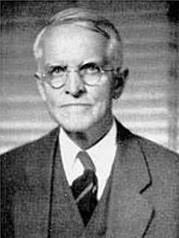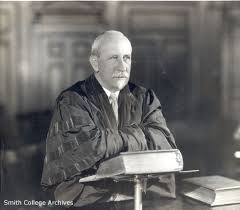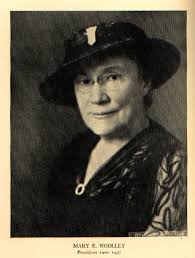**************************************************************************
THE EMERGENCY COMMITTEE IN AID OF DISPLACED FOREIGN SCHOLARS
**************************************************************************
Felix Warburg, Co-founder, “Advisor/ fund-raiser“.
Felix Moritz Warburg  (1871–1937): one of the many twisted scions of the Jewish Warburg (neé del-Banco) banking family of Hamburg, Germany.
(1871–1937): one of the many twisted scions of the Jewish Warburg (neé del-Banco) banking family of Hamburg, Germany.
 <<< ’s brothers: Paul = “father” of the (privately-owned) Federal Reserve Bank, etc., and Max = was one who (along with Oppenheimer and other strictly Jewish / Zionist interests) bankrolled Hitler and the Nazis, etc. Grandsons of Moses Marcus Warburg — one of the founders of the M. M. Warburg bank, founded in Hamburg, Germany in 1798.
<<< ’s brothers: Paul = “father” of the (privately-owned) Federal Reserve Bank, etc., and Max = was one who (along with Oppenheimer and other strictly Jewish / Zionist interests) bankrolled Hitler and the Nazis, etc. Grandsons of Moses Marcus Warburg — one of the founders of the M. M. Warburg bank, founded in Hamburg, Germany in 1798.
Felix Warburg was a partner in Kuhn, Loeb & Co., and an advocate of a Federal Reserve System for the United States. He married Frieda Schiff, daughter of Kuhn, Loeb & Co. senior partner Jacob Schiff. Their four sons, Frederick Marcus, Gerald Felix, Paul Felix and Edward Mortimer Morris, were all active in “community service”.
Warburg was an important leader in the American Jewish Joint Distribution Committee to help the Jews in Europe in the period leading up to, and especially during, the Great Depression. Warburg actively scammed to raise funds in the United States on behalf of European Jews who faced hunger following World War I. As early as 1919, he was quoted in the New York Times discussing the dire situation of Jewish war sufferers.
“The successive blows of contending armies have all but broken the back of European Jewry, and have reduced to tragically unbelievable poverty, starvation and disease about 6,000,000 souls [you don’t say? wow…6 million? really?], or half the Jewish population of the earth.” [12 Nov., 1919]
Warburg and the Joint Distribution Committee were also instrumental in the 1930s after the global stock exchange crash in 1929.
As a result of his “philanthropic” activities, a new Jewish village established in Mandate Palestine in 1939, Kfar Warburg, was named after him. http://en.wikipedia.org/wiki/Felix_M._Warburg
“…the committee “worked in close collaboration with the Rockefeller Foundation, the Oberlaender Trust, etc…”
Alan Gregg, “Co-Founder, Advisor/ fund-raiser“.
 Rockefeller Institute stooge & (medical) frontman, conman, bagman etc.
Rockefeller Institute stooge & (medical) frontman, conman, bagman etc.
Alan Gregg (1890–1957) undergraduate work at Harvard, earned his BA in 1911, finished his schooling in 1916 and, following a year-long internship at Massachusetts General Hospital, served in France from October 1917 to February 1919 as part of the Harvard Medical Unit in the British Army Medical Corps.
Meeting with the Rockefeller Foundation’s Victor Heiser in 1916. …after discharge from the medical corps, Gregg met with Wickliffe Rose, Director of the International Health Board, who offered him several choices of overseas assignments. Gregg selected Brazil, and in March 1919 began a three-year assignment, working with Lewis Hackett to extend the foundation’s hookworm control project to the South American country… .in 1922, Richard Pearce, Director of the Rockefeller Foundation’s Division of Medical Education, invited him to become Associate Director of the division, whose mission was to develop the teaching of scientific medicine around the world.
Gregg worked out of the Rockefeller Foundation’s Paris office from 1924 until 1930. He oversaw the fellowship program and all foundation activities supporting medical education and research in Europe. These efforts typically included surveys of countries where grants might be made, as well as funding recommendations for general medical education support and specific research projects. Gregg personally surveyed and wrote reports about medicine in Italy, Ireland, and Russia, among others. / directed the RI Medical Sciences Division through the 50s…Gregg served as the first Chairman of the Advisory Committee for Biology and Medicine of the Atomic Energy Commission from 1947 to 1953, as a member of the National Advisory Mental Health Council of the United States Public Health Service from 1946 to 1950, and as head of the sub-committee of the Task Force on Medical Services of the Second Hoover Commission on Organization of the Executive Branch of Government from 1954 to 1955. The latter group took the lead in recommending the creation of the National Library of Medicine, which Congress authorized in 1956, etc., etc. / http://profiles.nlm.nih.gov/FS/Views/Exhibit/other/visuals.html
Alfred E. Cohn, Assistant Treasurer.
Rockefeller Institute for Medical Research.
“Biography: Alfred Einstein Cohn (1879-1957), one of the first cardiologists in the U.S., became an associate and assistant physician at the hospital of The Rockefeller Institute of Medical Research in 1911. Within a few years he became the leader of the laboratory and clinical service devoted to the study of heart disease, a position he held until his retirement in 1944. His laboratory made contributions to knowledge in anatomy, embryology, physiology and biochemistry, as well as pathology and pharmacology. Cohn took a leading role in the activities of various organizations, and this collection documents his activities in the New York Heart Association, New York Academy of Medicine, Veterans Administration, China Medical Board, Asia Institute, Sydenham Hospital, and the Committee for Displaced Foreign Scholars and Displaced Foreign Physicians.” http://www.rockarch.org/collections/individuals/ru/
Alfred E. Cohn (1879-1957) was one of the first cardiologists in the US. He joined the Rockefeller Institute of Medical Research in 1911, and a few years later became leader of the laboratory and clinical service devoted to heart disease until retiring in 1944. He was involved in the New York Heart Association, New York Academy of Medicine, Veterans Administration, China Medical Board, Asia Institute, Sydenham Hospital, and the Committee for Displaced Foreign Scholars and Displaced Foreign Physicians. (Alfred E. Cohn Papers, 1900-(1920-1954)-1980. Rockefeller University Archives.) He was a member of the Board of Governors of the New York Heart Association. (New York Heart Association Appeals for Aid in Its Work. New York Times, Dec. 21, 1924.) In 1925 he was visiting professor at Union Medical College, Peking, China. During World War II he was a special advisor to the Board of Economic Welfare. (Alfred Einstein Cohn. College of Physicians and Surgeons Obituary Database.)
Alfred E. Cohn Papers / Rockefeller University
Alfred E. Cohn obituary / Columbia University
Cohn’s friends included Supreme Court Justice Felix Frankfurter; Dr. Peyton Rous; Melville H. Cane, New York lawyer who was a boyhood friend and was the executor of his estate; Dr. Henry A. Murray, Professor of Psychiatry at Harvard; and Dr. Detlev Bronk, head of the Rockefeller Institute. He left the Rockefeller Institute his library of 6,000 volumes. (Friends Honor Dr. A.E. Cohn at Library Dedication. New York Times Dec. 4, 1959.) http://www.smokershistory.com/pre1940.htm
Bernard Flexner.
 (1882-1946), a ‘New York’ lawyer, was a prominent member of the Zionist Organization of America. He served as counsel for the Zionist delegation to the Paris Peace Conference (1918-1919) and was president of the Palestine Economic Corporation. One of the founders of the Council on Foreign Relations. In 1917, Flexner traveled to Russia and Romania on Red Cross business, crossing the Siberian continent from the debarkation point of Vladivostock on supply trains that went to St. Petersburg, auspiciously bringing in materials for the Bolsheviks who took over the government only weeks later. http://citizen2009.wordpress.com/the-red-cross/
(1882-1946), a ‘New York’ lawyer, was a prominent member of the Zionist Organization of America. He served as counsel for the Zionist delegation to the Paris Peace Conference (1918-1919) and was president of the Palestine Economic Corporation. One of the founders of the Council on Foreign Relations. In 1917, Flexner traveled to Russia and Romania on Red Cross business, crossing the Siberian continent from the debarkation point of Vladivostock on supply trains that went to St. Petersburg, auspiciously bringing in materials for the Bolsheviks who took over the government only weeks later. http://citizen2009.wordpress.com/the-red-cross/
Fred M. Stein, Treasurer.
President of Montefiore Hospital.
Harvard Class of 1895: Fred (Michael) Stein (“Special student”) http://www.archive.org/stream/8threportclass1895harvuoft/8threportclass1895harvuoft_djvu / Married Beatrice Borg, from a prominent NY family (with members involved in such as the american jewish committee / dep’t of corrections / “committee on mental hygeine”, etc.) / Chairman of the Committee for the Care of Jewish Tuberculars / “Fred M. Stein, was involved in business and retired at an early age to lend his services to various health care associations in the community. Beatrice Borg Stein, worked to improve recreational and educational conditions for underprivileged children.” [His son, William Howard Stein, in partnership with Stanford Moore, was a pioneer in the field of protein chemistry. Stein and Moore began their collective work in the late 1930s under Max Bergmann at the Rockefeller Institute (now Rockefeller University). www.bookrags.com/biography/william-howard-stein-woc]
Charles J. Liebman.
President of the Refugee Economic Corporation.
“…Another body set up by Warburg was the Refugee Economic Corporation (originally called Refugee Rehabilitation Committee), which was incorporated in 1934. The success of this venture, in which Charles J. Liebman was the moving spirit, was not much greater. By the end of 1936 REC had appropriated $ 550,000, over half of it to the Huleh and other development projects in Palestine.” http://www.geschichteinchronologie.ch/judentum-aktenlage/hol/joint/Bauer_joint04-05-high-commissioner-McDonalds-ENGL.html
Nelson P. Mead, Secretary.
Nelson Prentiss Mead…leader in New York City “philanthropies” and professor of history at College of the City of New York (acting President 1938-41). Member on the boards of several Jewish organizations, including Chairman, Nat’l Advisory Council [<ZOA or?]
Charles A. Riegelman.
Lawyer. President of The Jewish Foundation for Education of Women.
Stephen P. Duggan, Secretary (1933-39), Chairman (1939-45).

Director of the Institute of International Education.
Livingston Farrand, Chairman (1933-39).


 Anthropologist, President of Cornell University.
Anthropologist, President of Cornell University.
Alvin “Lippo” (Saunders) Johnson.
 New School for Social Research.
New School for Social Research.
L. C. (Leslie Clarence) Dunn.
Geneticist, Columbia University Zoology Department.
Frank Aydelotte.



Henry Allen Moe.
Henry Allen Moe (1894-1975) served as trustee, officer, and committee member over thirty private foundations, including the American Trust for Oxford University; Clark Foundation; Ditson Fund for Music; Harry Frank Guggenheim Foundation; John Simon Guggenheim Foundation; Lalor Foundation; National Endowment for the Humanities (for which he served as its the first director); Rockefeller Foundation; Oberlaender Trust; Scriven Foundation; Louis Comfort Tiffany Foundation; Allen Tucker Memorial; Vetlesen Foundation; and the Maude E. Warwick Fund for Orphans of WW II. / As the first Secretary, then Administrator, and finally President of the John Simon Guggenheim Foundation (ca. 1925-1963), Moe made contact with the influential and the aspiring in the worlds of banking, finance, the arts, and sciences. / Principal administrator of the Simon Guggenheim Foundation from its inception through his 1963 retirement as well. “Keen interest” in Latin America, much of it generated through Moe’s oversight of the Guggenheim’s Latin America Fund…agriculture in the region, Peruvian archaeology, correspondence and grant reports from artists, writers, and politicians of South and Central America.
He served as a member or trustee of numerous institutions, organizations, and foundations, including the American Philosophical Society (elected 1943, also served as president); the New York State Historical Association (president and board chair); Farmers’ Museum (president); Leatherstocking Corporation, Cooperstown, NY; Maude E. Warwick Fund (trustee, vice-president); Wesleyan University (trustee emeritus); Scriven Foundation (trustee, consultant); Clark Foundation (trustee, consultant); Museum of Modern Art (vice-chair, trustees); Institute of Modern Art (chair trustees); American Academy in Rome (president, chair); Mary Imogene Bassett Hospital (president, chair trustees); Louis Comfort Tiffany Foundation (trustee); New York State Council on Arts (honorary vice chair); National Endowment for the Humanities (chair 1965-1966);
His vast correspondence, too extensive to describe in full, includes many correspondents of interest in banking, finance, the arts, and the sciences. http://www.amphilsoc.org/library/mole/m/moe.htm
Hertha Kraus.
Professor of social work at Bryn Mawr College.
Harlow Shapley.


 (1885 – 1972) Astronomer, Harvard University.
(1885 – 1972) Astronomer, Harvard University.
In the 1940’s, Shapley helped found government funded scientific associations, including the National Science Foundation. He is also responsible for the addition of the “S” in UNESCO (United Nations Educational, Scientific and Cultural Organization).
Edward R. Murrow, Secretary (1933-35).
John H. Whyte, Secretary (1935-1937).
Betty Drury, Secretary (1937-1944).
Francis Fenton Park, Secretary (1945).
General Committee:
Thomas (Stockham) Baker, Carnegie Institute of Technology
Lotus D. Coffman, University of Minnesota
Sir Arthur Currie, McGill University
notable freemason
Harold Willis Dodds, Princeton University
Sidney B. Fay, Harvard University
Abraham Flexner, Institute for Advanced Study
Harry A. Garfield, Williams College
Robert M. Hutchins, University of Chicago
James H. Kirkland, Vanderbilt University
James H. Kirkland, just 34 years old when he became chancellor (1893-1937), hailed from South Carolina. The son of an itinerant Methodist preacher, he attended Wofford College then received his Ph.D. at the University of Leipzig. With the help of colleagues he met during his German studies, he landed a job teaching Latin at Vanderbilt in 1886.
Kirkland remained in the post for 44 years, dealing with financial problems – the Methodist church was proving to be long on criticism and short on financial contributions – and fostering a number of projects designed to raise educational standards in the South.
In 1910, open warfare broke out between the Vanderbilt administration and the Methodist church. / Finally, in 1914, the Tennessee Supreme Court ruled against the bishops and the university’s separation from the church was complete. Kirkland led a thousand students through the streets in celebration etc.
The Rockefeller Foundation and the General Education Board also provided funding to build the full-time, research-oriented medical school dedicated to specialized scientific research and public health outreach, a medical school unlike any other in the South at that time.
Henry N. MacCracken, Vassar College
Robert A. Millikan, California Institute of Technology
Wesley C. Mitchell , Columbia University
 Wesley Clair Mitchell (1874–1948) U.S. economist. Educated at the University of Chicago under Thorstein Veblen and John Dewey, he later taught at several universities, including Columbia (1913–19, 1922–44). He helped found the National Bureau of Economic Research in 1920 and was its director of research until 1945. His work greatly influenced the development of quantitative studies of economic behaviour in the U.S. and abroad, and he was the foremost expert of his day on business cycles. / Mitchell served by presidential appointment on national committees on social trends (1929-1933), cost of living (1944), and others.
Wesley Clair Mitchell (1874–1948) U.S. economist. Educated at the University of Chicago under Thorstein Veblen and John Dewey, he later taught at several universities, including Columbia (1913–19, 1922–44). He helped found the National Bureau of Economic Research in 1920 and was its director of research until 1945. His work greatly influenced the development of quantitative studies of economic behaviour in the U.S. and abroad, and he was the foremost expert of his day on business cycles. / Mitchell served by presidential appointment on national committees on social trends (1929-1933), cost of living (1944), and others.
University: PhD, University of Chicago (1899) / Professor: University of Chicago (1899-02) / Economics, University of California at Berkeley (1902-12) / Columbia University (1913-19) / New School for Social Research (1919-21) / Columbia University (1922-44).
US War Industries Board Chief, Price Section (WWI) / National Bureau of Economic Research Director of Research (1920-45) / American Economic Association President (1923-24) / US Official National Planning Board (1933) / US Official National Resources Board (1934-35).
Harold G. Moulton, Brookings Institution
William A. Neilson, Smith College
George Norlin, University of Colorado
Marion Edwards Park, Bryn Mawr College
Walter Dill Scott, Northwestern University
Robert G. Sproul, University of California
Oswald Veblen, Institute for Advanced Study
Ray Lyman Wilbur, Stanford University
Ernest H. Wilkins, Oberlin College
Mary E. Woolley, Mount Holyoke College












































Leave a comment